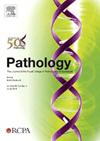早产儿和足月新生儿用棉球收集的尿液样本中肾脏标志物的浓度和外泌体的检测。
IF 3.6
3区 医学
Q1 PATHOLOGY
引用次数: 0
摘要
通过导尿管或耻骨上穿刺收集新生儿尿液样本会造成创伤,而自粘收集袋则会损伤脆弱的皮肤。另一种方法是用浸泡在尿布中的棉球收集尿样。本研究的目的是比较新生儿清洁尿液样本和棉球尿液样本中白蛋白、肌酐、中性粒细胞明胶酶相关脂质钙蛋白(NGAL)和尿调蛋白的浓度,并评估外泌体提取的效率。使用商用酶联免疫吸附试验(ELISA)试剂盒对标准的清洁尿液样本进行白蛋白、肌酐、NGAL 和尿肌球蛋白检测。将尿液浓度与立即从浸湿的棉球中提取的相同尿液样本(样本 2,S2)或从棉球中提取的尿液样本(样本 3,S3)进行比较。从一名患者的所有三个样本中提取外泌体,用电子显微镜进行观察。26 名婴儿(17 名男性)的出生胎龄中位数为 32+1 周,尿液采集时间中位数为 29 天,校正年龄为 37+6 周。在 S2 和 S3 中,分别有 46% 和 35% 的标本白蛋白浓度在标准样本浓度的 10% 以内,69% 和 58% 的标本肌酐浓度在标准样本浓度的 10% 以内,12% 和 12% 的标本 NGAL 浓度在标准样本浓度的 10% 以内,27% 和 15% 的标本尿蛋白浓度在标准样本浓度的 10% 以内,没有一致的阳性或阴性偏差。与标准样本相比,S2样本的尿白蛋白/肌酐比值(UACRs)低4.3%,S3样本低4.5%。从所有三种样本中都提取了外泌体并对其进行了可视化。从棉球中提取的新生儿尿液样本可用于筛查相关的白蛋白尿,但对NGAL和uromodulin的估计并不精确。从棉球尿液中提取外泌体的证明为检查外泌体货物提供了可能。本文章由计算机程序翻译,如有差异,请以英文原文为准。
Concentration of kidney markers and detection of exosomes in urine samples collected in cotton wool balls in preterm and term neonates
Collecting urine samples in neonates by catheterisation or suprapubic puncture causes trauma, whereas self-adhesive collection bags can damage fragile skin. An alternative method is the collection of samples from urine-soaked cotton wool balls placed in diapers. The aim of this study was to compare the concentration of albumin, creatinine, neutrophil gelatinase-associated lipocalin (NGAL), and uromodulin between clean-catch urine and samples collected in cotton wool balls in neonates and assess the efficiency of exosome extraction. Standard clean-catch urine samples were assayed for albumin, creatinine, NGAL, and uromodulin using commercial enzyme-linked immunosorbent assay (ELISA) kits. Concentrations were compared to the same urine samples extracted immediately from soaked cotton wool balls (sample 2, S2) or the urine extracted from cotton wool balls placed in a diaper in a warm incubator for 2 h before extraction (sample 3, S3). Exosomes were extracted from all three samples of one patient for visualisation by electron microscopy. Twenty-six infants (17 males) of median gestational age at birth of 32+1 weeks had urine collected at a median age of 29 days at 37+6 weeks corrected age. Concentrations in S2 and S3 were within 10% of the concentration of standard samples in 46% and 35% of specimens for albumin, 69% and 58% for creatinine, 12% and 12% for NGAL, and 27% and 15% for uromodulin, respectively, without consistent positive or negative bias. Urine albumin/creatinine ratios (UACRs) were 4.3% less in S2 and 4.5% less in S3 than in standard samples. Exosomes were extracted and visualised from all three sample types. Neonatal urine samples extracted from cotton wool balls can be used to screen for relevant albuminuria but provide imprecise estimates of NGAL and uromodulin. The proof of exosome extraction from urine collection in cotton wool balls opens the potential to examine exosomal cargo.
求助全文
通过发布文献求助,成功后即可免费获取论文全文。
去求助
来源期刊

Pathology
医学-病理学
CiteScore
6.50
自引率
2.20%
发文量
459
审稿时长
54 days
期刊介绍:
Published by Elsevier from 2016
Pathology is the official journal of the Royal College of Pathologists of Australasia (RCPA). It is committed to publishing peer-reviewed, original articles related to the science of pathology in its broadest sense, including anatomical pathology, chemical pathology and biochemistry, cytopathology, experimental pathology, forensic pathology and morbid anatomy, genetics, haematology, immunology and immunopathology, microbiology and molecular pathology.
 求助内容:
求助内容: 应助结果提醒方式:
应助结果提醒方式:


